Mom’s Choice Awards is excited to announce another post in our interview series where we chat with the inventors, designers, publishers, and others behind some of our favorite family-friendly products.
Hello, Mom’s Choice readers! Thank you so much for joining us again as we speak to honorees about their exciting award-winning products. For this interview, we were able to speak with Justin and Anne-Marie De Witt, the husband-wife developers of the very popular board game, Castle Panic. Since it’s a cooperative game where everyone defends their castle against a horde of monsters, there’s none of the typical board-game bickering—and it’s fun for the whole family. Playing Castle Panic helps kids understand logic and strategy, and it reinforces important skills such as teamwork, planning ahead, and the value of win-win. Keep reading to find out more about this enjoyable product and its creators!
MCA: Hi Justin and Anne-Marie, it’s such a pleasure to have you join us today to tell us how you came up with your innovative board games. First, why don’t you tell us a bit about yourselves—your backgrounds and interests? Anne-Marie, why don’t you start off?
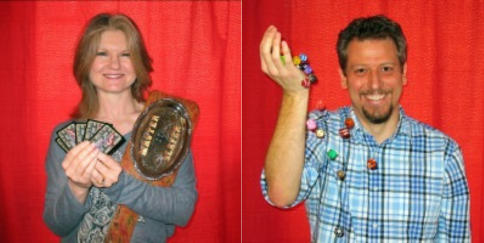
Anne-Marie and Justin De Witt!
We both moved around a lot as kids. Justin was raised in Los Alamos, New Mexico, and then in Seattle, Washington. I went from Kaufman, Texas, to Mishawaka, Indiana, and then to Seattle where we met. As a kid, Justin created board games to play with his friends, whether they wanted to or not. I was a voracious reader and developed a love of storytelling. We met when we were both working at Valley Medical Center in Renton, Washington. I was a speech-language pathologist and Justin was training staff on new software to schedule patients. Soon after, he earned dual degrees in graphic design and illustration at Western Washington University and went on to pursue animation, working on projects such as Blue’s Clues Birthday video games. We ended up moving to Austin, Texas, where I earned my master’s degree in creative writing. We fell in with a group of friends that played board games. After playing Settlers of Catan in 2000, Justin realized that his passion for creating board games had returned, and soon our friends were requesting his games to play.
MCA: Tell us about the creation of your company. What are your and Justin’s roles—how are they different, and how do you reinforce one another?
Because of the ongoing interest in our games and not seeing an immediate fit with existing brands, we decided to start Fireside Games. In 2009, we released Castle Panic under the Fireside Games brand. It was a hit from its launch and has become a staple in the market. We’re a small company, so we have to wear a lot of hats! Justin still designs most of the games we publish, but as the Chief Creative Officer, he’s involved in the development, graphic design, production, and manufacturing of all the games, whether they come from outside designers or not. I’m the Chief Executive Officer, which means I navigate the business, strategize and execute all our marketing, advertising, and conventions, and still do game development and design in my “free time.”
MCA: Free time—it’s hard to imagine you have much of that! Justin, what needs were you trying to fill when you created the Castle Panic board game?
While playing other games I had designed, I noticed that there were moments when the players would cooperate toward a common goal. This was before cooperative games were common, and the energy of those moments stuck with him. I focused on making a game that required players to work together with the game fighting back. We experimented with a few themes, but the idea of defending a castle together worked incredibly well. We used the classic fantasy monsters as the enemy, and with the Lord of the Rings movies hitting theaters around the same time, it all came together. We wanted to leave players with an exciting, almost cinematic experience where they struggled as a team to survive desperate odds, and we think we hit that mark nicely.
MCA: Clearly a successful strategy. Please tell us about the research behind the product’s unique features, and describe these features.
We had to break a lot of traditional game rules to make the cooperative gameplay work. For example, players don’t have their own pieces in the game. Instead, all the players are represented by the 6 towers and 6 walls that make up the castle. There’s no one piece that’s yours. You are all in it together, defending the entire castle as a whole. Coming up with a way to have some of the monsters in the game be stronger than others took a lot of trial and error. The solution we found was to make the monsters triangle-shaped tokens with their health shown as numbers 1 to 3 on the corners of the triangle. Monsters keep their current health pointed toward the castle, so when a player damages a monster, they can simply rotate the token so the next-lowest number is pointed at the castle.
MCA: What elements of this game can be helpful to childhood development, and why?
Teamwork and cooperation are important skills for young players to learn. Castle Panic stands out in letting all the players ask questions, talk about their strategy openly, and not be embarrassed or afraid of making mistakes. Players don’t have to worry about not playing correctly. Everyone can (and must) support everyone else if the team is going to win. Learning to plan ahead is another key skill Castle Panic supports. Trading cards is a huge part of the game and as players learn to plan ahead, they realize the trade they make isn’t just about what’s best for their own turn, it needs to benefit the next player, and even the player after that as well.
MCA: Why have your games been so successful, would you say?
For a lot of players, Castle Panic is the first time they have played a cooperative game. It’s a new experience, and we worked hard to make sure it would be easy to learn, not take too long, and provide an exciting sense of tension. The random nature of the monsters means every game is different, so it’s game players can return to over and over again. Plus, we have four expansions players can add to take the game to a whole new level.
MCA: Anne-Marie, what kind of feedback have you received about the game?
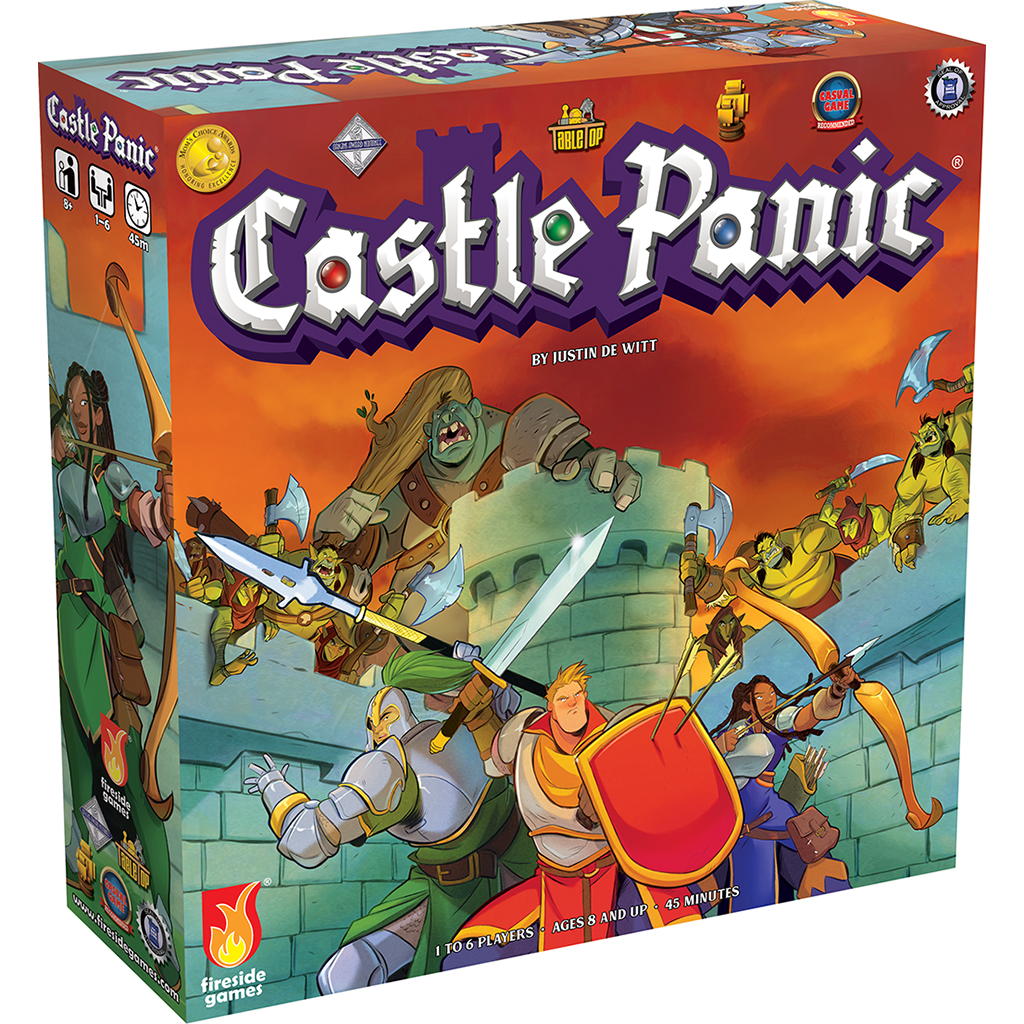
Castle Panic made passionate fans from the first printing. We’ve lost count of the number of times fans have told us, “This is the game that got me into gaming!” or “This is the first game I ever bought!” We constantly hear about kids who normally fight or bicker being able to sit down and play Castle Panic together as a team. We’ve also won a series of awards we’re incredibly proud of, including the Mom’s Choice Award.
MCA: Specifically, how has My First Castle Panic been received—and in what order were the two versions developed?
Castle Panic came first, and it was incredibly successful. It didn’t take long to get feedback that there was a demand for a simpler, more basic version of Castle Panic that preschoolers could play. We released My First Castle Panic in 2019, and it was an immediate hit. We quickly sold out and heard from parents that their kids kept wanting to play the game again and again, so they couldn’t even put the game away! My First Castle Panic continues to be one of our bestsellers and wins award after award, including the Mom’s Choice Award.
MCA: Did Castle Panic fill any special needs during the pandemic?
We got a lot of comments during the pandemic that people were grateful to have a game like Castle Panic, knowing that it wouldn’t result in hurt feelings or sore losers when stress was already high. It was a fun, positive experience that brought players together and let them be heroes in a time when everything was so uncertain. We’re very proud to have helped so many families through that tough time.
MCA: Justin, please tell us about the new art you’ve developed and how have players responded.
The word “love” comes up a lot. Castle Panic received its first big art refresh after almost 13 years, and it was worth the wait. The new art is brighter and more energetic. It features better representation and is much more inclusive. We improved the graphic design to help color-blind players and streamline the gameplay. We’ve already received a mountain of compliments on how much fans of the original version love the new art. Several color-blind players have reached out to let us know that they adore the changes we made. We’re incredibly happy with how the art came out and how well it’s been embraced.
MCA: What is next for Castle Panic/Fireside Games?
We’ve got several new games we’re working on, including another cooperative adventure game. This time players will be entering the world of Ham Helsing, a vampire-hunting pig. The game is based on the graphic novel by Rich Moyer and will feature his artwork and lots of pig puns as players team up to battle monsters to save the town of Mud Canyon!
MCA: Anne-Marie and Justin, it sounds like you’ll soon have another people-pleasing winner on your hands. Congratulations again for your superb and original products that have won accolades from so many players!
You can learn more about Yvonne M Morgan and her award-winning book, Castle Panic, by visiting her MCA Shop pages.

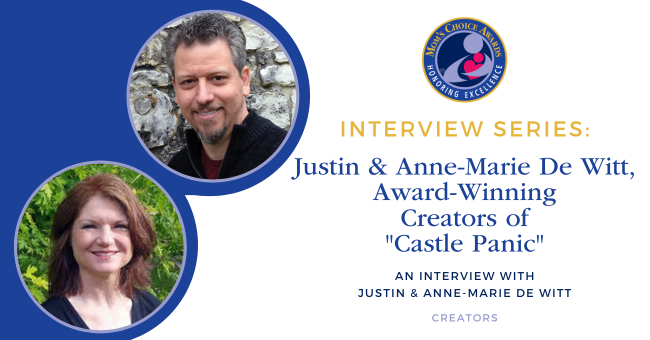
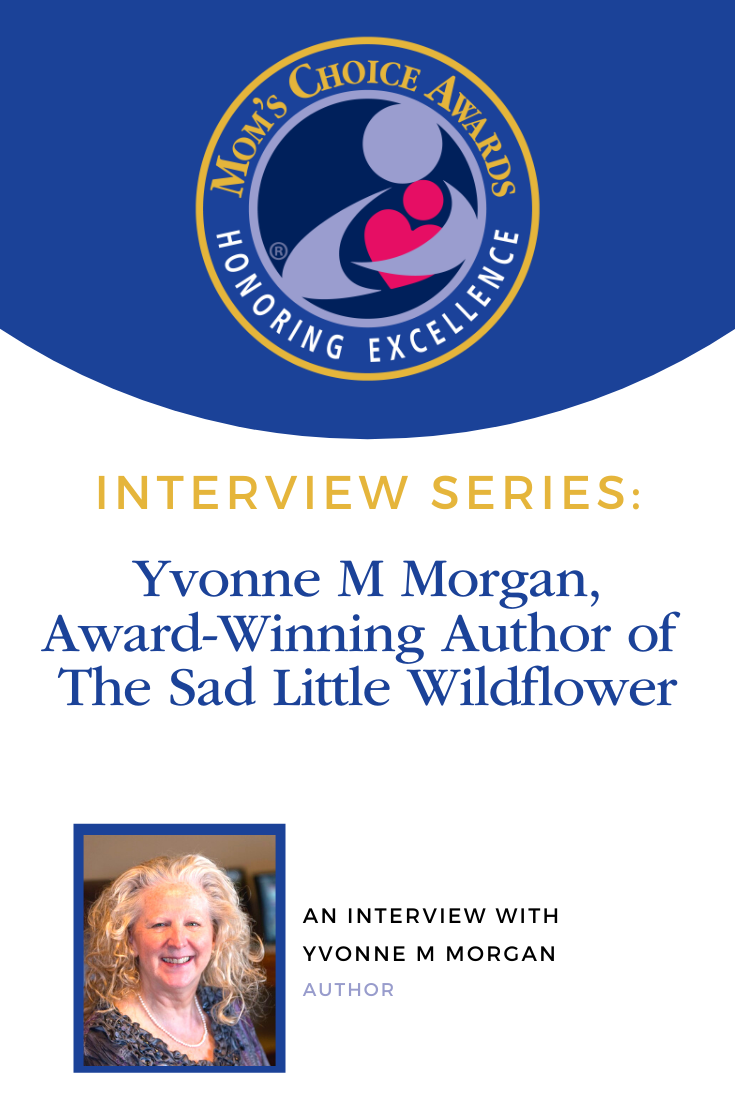
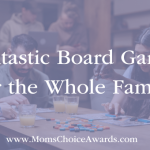
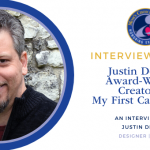


5 Comments on “Interview with Mom’s Choice Award-Winners Justin and Anne-Marie De Witt”
Sounds like some great games!
Thanks for all the info, this sounds interesting and fun, what a great learning tool as well.
What a great achievement! I love these types of games!
It is so nice to have a game where everyone who plays can just have fun. So many games are competitive when it comes to playing that it just isn’t fun anymore.
This is so interesting, and we love Castle Panic Fireside games!!